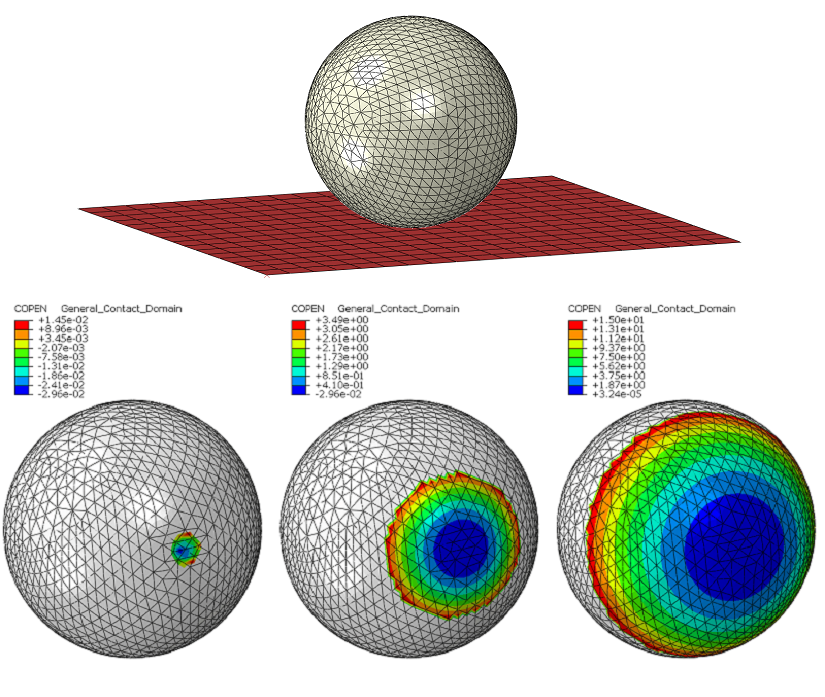
Products: Abaqus/Standard Abaqus/Explicit
Benefits: You can now request additional contact output variables for general contact in Abaqus/Explicit that were previously available only for Abaqus/Standard.
Description: The following output is now available for general contact in Abaqus/Explicit:
Contact opening distance, total slip length, and components of accumulated slip in local tangent directions: The opening distance variable (COPEN) is reported where contact surfaces are touching or nearly touching, and the slip output variables reflect slip accumulated only while contact surfaces are touching (i.e., while contact constraints are active). Figure 13–1 shows an example contour plot of the total slip length output variable (CSLIPEQ). See the discussion of the generic output variable CDISP and associated variables COPEN, CSLIPEQ, CSLIP1, and CSLIP2 in “Defining general contact interactions in Abaqus/Explicit,” Section 36.4.1 of the Abaqus Analysis User's Guide, for further information.
Magnitude of the current slip rate and components of the current slip rate in the respective local tangent directions: These output variables are reported only where contact is active. See the discussion of the generic output variable CSLIPR and associated output variables CSLIPRMAG, CSLIPR1, and CSLIPR2 in “Defining general contact interactions in Abaqus/Explicit,” Section 36.4.1 of the Abaqus Analysis User's Guide, for further information.
Current local tangent direction vectors ![]() and
and ![]() : It can be helpful to view a vector plot of CTANDIR1 alongside a contour plot of CSLIP1 (or CSLIPR1) to see in which direction the
: It can be helpful to view a vector plot of CTANDIR1 alongside a contour plot of CSLIP1 (or CSLIPR1) to see in which direction the ![]() -component of slip (or slip rate) acts. These output variables are provided only where contact is active. See the discussion of the generic output variable CTANDIR and associated output variables CTANDIR1 and CTANDIR2 in “Defining general contact interactions in Abaqus/Explicit,” Section 36.4.1 of the Abaqus Analysis User's Guide, for further information.
-component of slip (or slip rate) acts. These output variables are provided only where contact is active. See the discussion of the generic output variable CTANDIR and associated output variables CTANDIR1 and CTANDIR2 in “Defining general contact interactions in Abaqus/Explicit,” Section 36.4.1 of the Abaqus Analysis User's Guide, for further information.
Contact status (CSTATUS): This output indicates if two surfaces are in contact or not (closed or open) and, in the case they are in contact, if they are sticking or slipping.
The generic output variable CTANDIR and associated output variables CTANDIR1 and CTANDIR2 are also now available for Abaqus/Standard. Many of the other contact output variables mentioned above were previously available only for Abaqus/Standard.
In addition, you can extend the range for which general contact in Abaqus/Explicit provides contact opening output. COPEN output is provided up to gap distances equal to the value you specify for the “tracking thickness.” By default, this value is very small to minimize computational time. The ability to modify the tracking thickness was previously available for Abaqus/Standard but only for special cases in Abaqus/Explicit. Consider the example shown in Figure 13–2 of a sphere with a radius of 15 mm. The results shown correspond to a deformed state with a small active contact region and the following values for the tracking thickness: default value (which is very small) for the case on the left, 3.5 mm for the case in the middle, and 15 mm for the case on the right. Small negative values of COPEN in Figure 13–2 are associated with small penetrations due to penalty enforcement of contact conditions. Using the tracking thickness control may increase run time due to extra contact search computations, especially if you specify a large tracking thickness value.
Figure 13–2 Contact opening output with different values of tracking thickness on a sphere touching a plane.
